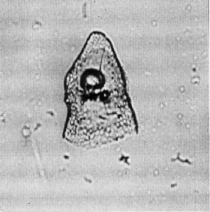 Centrobotrys
thermophila Petrushevskaya
Centrobotrys
thermophila Petrushevskaya Centrobotrys
thermophila Petrushevskaya
Centrobotrys
thermophila PetrushevskayaCentrobotrys thermophila Petrushevskaya, 1965, p.115, text- fig.20; Nigrini, 1967, p.49, text-fig.26, pl.5, fig.7
Internal [eucephalic] lobe heavy, spherical with small, closely spaced, subcircular pores, surface rough. This lobe is supported above the collar stricture by 3 stout rods or spines, 2 of which are attached to the primary laterals. The third is part of the apical spine, and originates at one end of the median bar. As it passes through the wall of the [eucephalic] lobe, it is flanked by 2 pairs of pores; it leaves the lobe as a cylindrical, needle-like spine that may or may not pierce the outer [eucephalic] wall. Vertical spine ends as a small thorn in one of the pores of the internal [eucephalic] lobe. Slender, cylindrical primary lateral, dorsal, and ventral spines extend outwards, and usually a little downwards, from the collar structure, often piercing the outer shell. The ventral spine originates near the upper end of the vertical spine. Short secondary laterals and an axial rod are also present. A pair of stout rods extend from either side of the vertical spine to the wall of the outer [eucephalic] shell. Outer shell approximately triangular in outline, often with a slight collar stricture; elliptical in transverse section. It is thin-walled, hyaline, and smooth with many, irregularly scattered, small circular pores. Termination invariably ragged (Nigrini, 1967).
Maximum length 90-128 mm. Maximum breadth 63-81 mm (Nigrini, 1967).
Total length 80-130 mm, maximum breadth 50-85 mm (Sanfilippo et al., 1985).
This species differs from C. petrushevskayae by the shell being more pointed apically, and having a poreless area around the eucephalic lobe (Sanfilippo et al., 1985).
This species varies little in form. The merged ante- and post-cephalic lobes have an outline that is usually pointed apically, irregularly wavy in rare specimens, and there is no distinct change in contour between the cephalis and the broad thorax. Thoracic length is similar to that of thorax, or less. Pores in the shell wall are small and unevenly distributed, quite lacking near the eucephalic lobe (Sanfilippo et al., 1985).
C. thermophila occurs widely in late Oligocene to Holocene sediments from all oceans, in latitudes lower than 30°, but in small numbers. Its morphotypic first appearance is within the Dorcadospyris ateuchus Zone.
C. thermophila is the extant member of the lineage that commenced in the early Oligocene with C. gravida, and evolved through C. petrushevskayae.